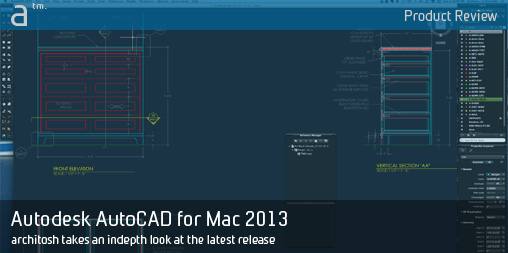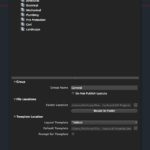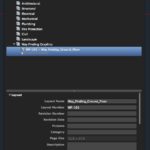In version 2011–it’s debut version–the program lacked a few items that made it a deal-breaker for many users. Chief among these were enterprise-level customization capabilities and support for the vast array of 3rd-party AutoCAD extensions. Although AutoCAD for Mac was entirely written from scratch (versus a Windows port) for the advanced OS X platform, Autodesk states that AutoCAD in its present state was based on much of the same source code as the Windows version. As such there is true compatibility between both the Mac and Windows versions. And AutoCAD for Mac 2013 can open (read) files from AutoCAD version 14 to the present.
Advertisement
One of the nice things about AutoCAD for Mac 2013 is that it can play nice in a mixed AutoCAD setting. The program supports both network and standalone licensing as well as cross-platform licensing. This makes it easy for IT and CAD managers to try to mix in a blend of Mac-based AutoCAD workstations into a design or engineering studio. Of course, while other Windows-only issues may still prevail, the licensing simplification is a headache eliminated.
What’s In – What’s Still Not
Before we head into taking a more detailed look at AutoCAD for Mac 2013, we should scan various other features that are not supported in the Mac version of AutoCAD yet. Let’s start with customization. AutoCAD for Mac 2013 doesn’t support many areas of customization that are typical to the Windows version. The argument here is Mac users, by-and-large, don’t care about such things and are more than happy with or even desire the pre-packaging and control that typically comes with Apple’s platforms, (see, “Autocad’s Fateful Return to the Mac–The Full Story,” Architosh, 17 Dec 2010).
Interestingly, Autodesk list Ribbon Customization as a feature that the Mac does not have. That’s quite okay with us Mac CAD and 3D users–as Apple users we don’t tend to think much of Microsoft’s user-interface creations and we are well aware of the debacle associated with the adoption of the MS Ribbon user-interface feature in many a CAD application.
While AutoCAD for Mac 2013 supports CUI files, Command Aliases, ObjectARX and LISP, it doesn’t support some customization features which end users and third-party developers may wish to have. For instance, users cannot do things like password protect drawings or digital signatures. There is no workspaces and CAD standards tools. Perhaps in later versions some of these items will make their way over.
Workflow connectivity is decently robust in AutoCAD for Mac 2013 with key items like SAT import and export and Autodesk WS and 360 Connectivity. Because many landscape architects, architects and civil engineering professionals use Microstation it would be nice to see DGN underlay support added like it exist in Windows. Another missing key piece of interoperability is AutoCAD FBX.
What’s New and Cool in 2013
There are a lot of new features in AutoCAD for Mac 2013 and most follow along what is new on the Windows version. This is equally true of the most important new features. For example Context Sensitive PressPull is a new capability with modeling and is common to both platforms. On the other hand, sometimes a new feature actually debuted on the Mac version, like Surface Curve Extraction, which is only new to AutoCAD 2013 for Windows this year as it was present in the 2012 version on the Mac.
Context Sensitive PressPull
We think the new Context Sensitive PressPull features are cool updates and so let’s review them here a bit in detail. A new feature is the Control key modification of a pull or push surface at an angle associated with a shape. The default function of the presspull tool extrudes a face straight out; the control-key option pulls the face in offset mode relative to another angle. (see comparison in the images below, images 01 – 02). And further updates to the presspull tool allow it to act on open 2D shapes like a spline.

01 – The context-sensitive presspull tool has new options. You can pull faces parallel to themselves (normal mode) as shown.

02 – The presspull tool has a new option to pull faces out in relation to an angled face on the object, as seen in this image as compared to the previous view.
New Project Manager
While not as interesting from a design perspective as the modeling improvements noted above, the Project Manager (or Sheet Set Manager) is an important big new feature.
For those new to AutoCAD on any platform, a Project in AutoCAD is an organized collection of layouts from several drawing files. Another term in this program for a Project is a Sheet Set. Same thing. As we all know, sets of drawings are the primary deliverable from architects and engineers and managing these sets of drawings at the CAD-organization level can be complicated and tedious. Autodesk’s new Project Manager palette (see images 03 – 05) allows you to create a project from scratch or use an existing project to define properties.
From the main Project Manager palette you can open up recently opened projects, create new projects, create new groups and layouts, associate files and layouts with a particular project and eliminate items as well. You can also publish your projects (sheet sets) in addition to use the Project Manager palette to locate and reveal files (in the Finder) used in layouts and sets. In our example project, named “New_2013_test,” we added a Way Finding group and created a new file and layout based on standard templates. (see images 04 – 05).
Key to this review of AutoCAD for Mac 2013, it is important to note that one can use the Projects feature in a multiple operating system environment. For all releases of AutoCAD and AutoCAD LT that support the Sheet Set Manager on Windows and AutoCAD for Mac that support the new Project Manager on OS X, a multi-platform environment can be fully configured in an office, utilizing the benefits of Projects to orchestrate team work. The Project (DST) file that gets created is an XML-based file which allows files to be used between both platforms. The one key ingredient is to make sure all drawing files (DWGs) referenced by the layouts in the Project Manager (Sheet Set Manager on Windows) are located in a network location (i.e.: server) that is accessible to both Windows and Mac OS X. A Mac OS X Lion Server would be ideal since OS X Server fully supports mixed operating systems.
Next page: PDF Underlayment Feature and more







Reader Comments
Comments for this story are closed